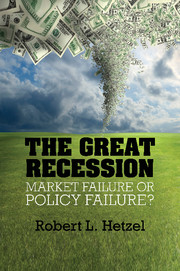Book contents
- Frontmatter
- Contents
- Figures
- Tables
- Preface
- One The 2008–2009 Recession
- Two Recessions
- Three The Great Contraction
- Four Monetary Policy and Bank Runs in the Great Depression
- Five Vigorous Recovery and Relapse
- Six Interwar International Monetary Experiments
- Seven Identifying the Shocks that Cause Recessions
- Eight From Stop-Go to the Great Moderation
- Nine Controlling Bank Risk Taking
- Ten The Housing Crash
- Eleven Bubble Trouble
- Twelve What Caused the Great Recession of 2008–2009?
- Thirteen What Caused the Great Leverage Collapse?
- Fourteen The Distinctions Between Credit, Monetary, and Liquidity Policy
- Fifteen Fed Market Interventions
- Sixteen Evaluating Policy
- Seventeen The Business Cycle
- Eighteen Why Is Learning So Hard?
- Nineteen How Should Society Regulate Capitalism?
- Postscript
- Bibliography
- Index
- References
Six - Interwar International Monetary Experiments
Published online by Cambridge University Press: 05 May 2012
- Frontmatter
- Contents
- Figures
- Tables
- Preface
- One The 2008–2009 Recession
- Two Recessions
- Three The Great Contraction
- Four Monetary Policy and Bank Runs in the Great Depression
- Five Vigorous Recovery and Relapse
- Six Interwar International Monetary Experiments
- Seven Identifying the Shocks that Cause Recessions
- Eight From Stop-Go to the Great Moderation
- Nine Controlling Bank Risk Taking
- Ten The Housing Crash
- Eleven Bubble Trouble
- Twelve What Caused the Great Recession of 2008–2009?
- Thirteen What Caused the Great Leverage Collapse?
- Fourteen The Distinctions Between Credit, Monetary, and Liquidity Policy
- Fifteen Fed Market Interventions
- Sixteen Evaluating Policy
- Seventeen The Business Cycle
- Eighteen Why Is Learning So Hard?
- Nineteen How Should Society Regulate Capitalism?
- Postscript
- Bibliography
- Index
- References
Summary
As a professor at Princeton, Ben Bernanke (2000, 149, 165) criticized the Japanese central bank for a lack of decisive action to address its economy’s “deep slump” in the 1990s by contrasting its inaction with the action of President Roosevelt in the Depression.
Franklin D. Roosevelt was elected president of the United States in 1932 with the mandate to get the country out of the Depression…. In the end, his most effective actions were the same ones that Japan needs to take – namely, rehabilitation of the banking system and devaluation of the currency. But Roosevelt’s specific policy actions were, I think, less important than his willingness to be aggressive and to experiment – in short, to do whatever it took to get the country moving again.
Bernanke (2002) returned to the issue of leadership when he wrote about the death of Benjamin Strong in 1928, governor of the New York Fed:
[T]he central bank … was essentially leaderless….This situation led to decisions, or nondecisions, which might well not have occurred under either better leadership or a more centralized institutional structure. And associated with these decisions, we observe a massive collapse of money, prices, and output.
- Type
- Chapter
- Information
- The Great RecessionMarket Failure or Policy Failure?, pp. 85 - 109Publisher: Cambridge University PressPrint publication year: 2012

